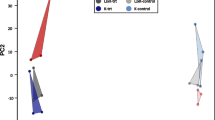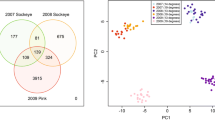Abstract
The objective of the study reported here was to investigate genes related to upper temperature tolerance in rainbow trout Oncorhynchus mykiss, a cold-water species with considerable economic importance, by global gene expression analysis using a next generation sequencing system. Fifty million paired sequences were collected from the gill tissues of each of five individuals of a thermally selected strain developed by selective breeding and from the gill tissues of a standard Donaldson strain and assembled into transcripts. The data of both strains were integrated, and a BLASTX search identified 13,092 independent, known genes. A back-mapping of raw reads from both strains onto the genes, conducted to investigate their frequency of expression, revealed that 324 genes showed at least a twofold higher expression in the thermally selected strain than in the Donaldson strain. In addition, 44.4 % of commonly expressed genes were categorized into 38 functional groups by annotation. Genes encoding heat shock proteins and c-fos-related proteins were highly expressed in the thermally selected strain. Our strategy to employ next generation sequencing proved to be very useful to find genes responsible for upper temperature tolerance of rainbow trout.


Similar content being viewed by others
References
Food and Agriculture Organization of the United Nations (2009) Global aquaculture production of Oncorhynchus mykiss. FAO Fishery Statistic, FAO, Geneva
Masuda H, Amaoka K, Araga T, Ueno T, Yoshino T (1992) The fishes of the Japanese archipelago. Tokai University Press, Tokyo
Donaldson LR, Olson PR (1955) Development of rainbow trout bloodstock by selective breeding. Trans Am Fish Soc 85:93–101
Ineno T, Tsuchida S, Kanda K, Watabe S (2005) High temperature tolerance of rainbow trout Oncorhyncus mykiss selected by high temperature breeding. Fish Sci 71:767–775
Chen JD, Yew FH, Li GC (1988) Thermal adaptation and heat shock response of tilapia ovary cells. J Cell Physiol 134:189–199
Fangue NA, Hofmeister M, Schulte PM (2006) Intraspecific variation in thermal tolerance and heat shock protein gene expression in common killifish, Fundulus heteroclitus. J Exp Biol 209:2859–2872
Ojima N, Yamashita M, Watabe S (2005) Comparative expression analysis of two paralogous Hsp70s in rainbow trout cells exposed to heat stress. Biochim Biophys Acta 1681:99–106
Ojima N, Yamashita M, Watabe S (2005) Quantitative mRNA expression profiling of heat shock protein families in rainbow trout cells. Biochem Biophys Res Commun 329:51–57
Heredia-Middleton P, Brunelli J, Drew RE, Thorgaard GH (2008) Heat shock protein (HSP70) RNA expression differs among rainbow trout (Oncorhynchus mykiss) clonal lines. Comp Biochem Physiol Part B 149:552–556
Quinn NL, McGowan CR, Cooper CA, Koop BF, Davidson WS (2011) Identification of genes associated with heat tolerance in Arctic charr exposed to acute thermal stress. Physiol Genomics 43:685–696
Somorjai IML, Danzmann RG, Ferguson MM (2003) Distribution of temperature tolerance quantitative trait loci in Arctic charr (Salvelinus alpinus) and inferred homologies in rainbow trout (Oncorhynchus mykiss). Genetics 165:1443–1456
Danzmann RG, Jackson TR, Ferguson MM (1999) Epistasis in allelic expression at upper temperature tolerance QTL in rainbow trout. Aquaculture 173:45–58
Perry GM, Danzmann RG, Ferguson MM, Gibson JP (2001) Quantitative trait loci for upper thermal tolerance in outbred strains of rainbow trout (Oncorhynchus mykiss). Heredity 86:333–341
Jackson TR, Ferguson MM, Danzmann RG, Fishback AG, Ihssen PE, O’Connell M, Crease TJ (1998) Identification of two QTL influencing upper temperature tolerance in three rainbow trout (Oncorhynchus mykiss) half-sib families. Heredity 80:143–151
Ikeguchi K, Ineno T, Itoi S, Kondo H, Kinoshita S, Watabe S (2005) Increased levels of mitochondrial gene transcripts in the thermally selected rainbow trout (Oncorhynchus mykiss) strain during embryonic development. Mar Biotechnol 8:178–188
Shendure J, Ji H (2008) Next-generation DNA sequencing. Nat Biotechnol 26:1135–1145
Pan Q, Shai O, Lee LJ, Frey BJ, Blencowe BJ (2008) Deep surveying of alternative splicing complexity in the human transcriptome by high-throughput sequencing. Nat Genet 40:1413–1415
Jager M, Ott C, Grunhagen J, Hecht J, Schell H, Mundlos S, Duda GN, Robinson PN, Lienau J (2011) Composite transcriptome assembly of RNA-seq data in a sheep model for delayed bone healing. BMC Genomics 12:158
Martin JA, Wang Z (2011) Next-generation transcriptome assembly. Nat Rev Genet 12:671–682
Salem M, Rexroad CE, Wang J, Thorgaard GH, Yao J (2010) Characterization of the rainbow trout transcriptome using Sanger and 454-pyrosequencing approaches. BMC Genomics 11:564
Hale MC, McCormick CR, Jackson JR, Dewoody JA (2009) Next-generation pyrosequencing of gonad transcriptomes in the polyploid lake sturgeon (Acipenser fulvescens): the relative merits of normalization and rarefaction in gene discovery. BMC Genomics 10:203
Weber AP, Weber KL, Carr K, Wilkerson C, Ohlrogge JB (2007) Sampling the Arabidopsis transcriptome with massively parallel pyrosequencing. Plant Physiol 144:32–42
Wang W, Wang Y, Zhang Q, Qi Y, Guo D (2009) Global characterization of Artemisia annua glandular trichome transcriptome using 454 pyrosequencing. BMC Genomics 10:465
Crawford JE, Guelbeogo WM, Sanou A, Traore A, Vernick KD, Sagnon N, Lazzaro BP (2010) De novo transcriptome sequencing in Anopheles funestus using Illumina RNA-seq technology. PLoS One 5:e14202
Bonizzoni M, Dunn WA, Campbell CL, Olson KE, Dimon MT, Marinotti O, James AA (2011) RNA-seq analyses of blood-induced changes in gene expression in the mosquito vector species, Aedes aegypti. BMC Genomics 12:82
Simpson JT, Wong K, Jackman SD, Schein JE, Jones SJ, Birol I (2009) ABySS: a parallel assembler for short read sequence data. Genome Res 19:1117–1123
Pearson WR, Wood T, Zhang Z, Miller W (1997) Comparison of DNA sequences with protein sequences. Genomics 46:24–36
Zerbino DR, Birney E (2008) Velvet: algorithms for de novo short read assembly using de Bruijn graphs. Genome Res 18:821–829
Pevzner PA, Tang H, Waterman MS (2001) An Eulerian path approach to DNA fragment assembly. Proc Natl Acad Sci USA 98:9748–9753
Li W, Godzik A (2006) Cd-hit: a fast program for clustering and comparing large sets of protein or nucleotide sequences. Bioinformatics 22:1658–1659
Langmead B, Trapnell C, Pop M, Salzberg SL (2009) Ultrafast and memory-efficient alignment of short DNA sequences to the human genome. Genome Biol 10:R25
Li H, Handsaker B, Wysoker A, Fennell T, Ruan J, Homer N, Marth G, Abecasis G, Durbin R (1000) Genome Project Data Processing Subgroup (2009) The sequence alignment/map (SAM) format and SAMtools. Bioinformatics 25:2078–2079
Conesa A, Götz S, García-Gómez JM, Terol J, Talón M, Robles M (2005) Blast2GO: a universal tool for annotation, visualization and analysis in functional genomics research. Bioinformatics 21:3674–3676
Rexroad CE, Lee Y, Keele JW, Karamycheva S, Brown G, Koop B, Gahr SA, Palti Y, Quackenbush J (2003) Sequence analysis of a rainbow trout cDNA library and creation of a gene index. Cytogenet Genome Res 102:347–354
Govoroun M, LeGac F, Guiguen Y (2006) Generation of a large scale repertoire of expressed sequence tags (ESTs) from normalised rainbow trout cDNA libraries. BMC Genomics 7:196
Sørensen JG, Kristensen TN, Loeschcke V (2003) The evolutionary and ecological role of heat shock proteins. Ecol Lett 6:1025–1037
Feder ME, Hofmann GE (1999) Heat-shock proteins, molecular chaperones, and the stress response: evolutionary and ecological physiology. Annu Rev Physiol 61:243–282
Roberts RJ, Agius C, Saliba C, Bossier P, Sung YY (2010) Heat shock proteins (chaperones) in fish and shellfish and their potential role in relation to fish health: a review. J Fish Dis 33:789–801
Boone AN, Vijayan MM (2002) Constitutive heat shock protein 70 (HSC70) expression in rainbow trout hepatocytes: effect of heat shock and heavy metal exposure. Comp Biochem Physiol C 132:223–233
Ojima N, Mekuchi M, Ineno T, Tamaki K, Kera A, Kinoshita S, Asakawa S, Watabe S (2012) Differential expression of heat-shock proteins in F2 offspring of a thermally-selected rainbow trout strain. Fish Sci. doi:10.1007/s12562-012-0523-3
Summers DW, Douglas PM, Ramos CH, Cyr DM (2009) Polypeptide transfer from Hsp40 to Hsp70 molecular chaperones. Trends Biochem Sci 34:230–233
Pearson DS, Kulyk WM, Kelly GM, Krone PH (1996) Cloning and characterization of a cDNA encoding the collagen-binding stress proteins Hsp47 in zebrafish. DNA Cell Biol 15:263–271
Basu N, Todgham AE, Ackerman PA, Bibeau MR, Nakano K, Schulte PM, Iwama GK (2001) Heat shock protein genes and their functional significance in fish. Gene 295:173–183
Vogt S, Portig I, Irqsusi M, Ruppert V, Weber P, Ramzan R (2011) Heat shock protein expression and change of cytochrome c oxidase activity: presence of two phylogenic old systems to protect tissues in ischemia and reperfusion. J Bioenerg Biomembr 43:425–435
Montero-Barrientos M, Hermosa R, Cardoza RE, Gutierrez S, Nicolás C, Monte E (2010) Transgenic expression of the Trichoderma harzianum hsp70 gene increases Arabidopsis resistance to heat and other abiotic stresses. J Plant Physiol 167:659–665
Dedeoglu A, Ferrante RJ, Andreassen OA, Dillmann WH, Beal MF (2002) Mice overexpressing 70-kDa heat shock protein show increased resistance to malonate and 3-nitropropionic acid. Exp Neurol 176:262–265
Sheng M, Greenberg ME (1990) The regulation and function of c-fos and other immediate early genes in the nervous system. Neuron 4:477–485
Wilkerson DC, Skaggs HS, Sarge KD (2007) HSF2 binds to the Hsp90, Hsp27, and c-Fos promoters constitutively and modulates their expression. Cell Stress Chaperones 12:283–290
Acknowledgments
This study was supported in part by a grant from the Ministry of Agriculture, Forestry, and Fisheries of Japan.
Author information
Authors and Affiliations
Corresponding author
Additional information
S. Asakawa and S. Watabe contributed equally to this work.
Electronic supplementary material
Below is the link to the electronic supplementary material.
12562_2012_522_MOESM2_ESM.ppt
Bioinformatics workflow of this study. This figure summarizes the analytical steps for quality selection, de novo assembly, annotation, and read mapping with software packages in the respective steps of in this study (PPT 190 kb)
Rights and permissions
About this article
Cite this article
Tan, E., Wongwarangkana, C., Kinoshita, S. et al. Global gene expression analysis of gill tissues from normal and thermally selected strains of rainbow trout. Fish Sci 78, 1041–1049 (2012). https://doi.org/10.1007/s12562-012-0522-4
Received:
Accepted:
Published:
Issue Date:
DOI: https://doi.org/10.1007/s12562-012-0522-4




